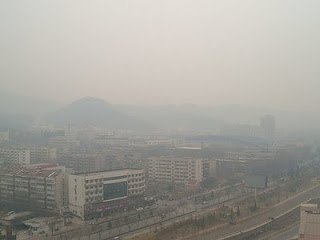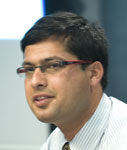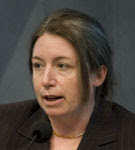-
Energy, Climate Change, National Security Are Closely Linked, Assert Retired Generals, Admirals
›May 18, 2009 // By Rachel WeisshaarThe United States’—and the Department of Defense’s (DoD)—dependence on fossil fuels poses a significant national-security threat, concludes Powering America’s Defense: Energy and the Risks to National Security (summary), the second report from CNA’s Military Advisory Board (MAB), a group of 12 retired three- and four-star admirals and generals. At the report’s launch this morning, several members of the MAB were joined by several of the people they are trying to influence, including Under Secretary of Defense for Acquisition, Technology, and Logistics Ashton Carter and Deputy Assistant Secretary of State for Energy, Sanctions, and Commodities Douglas Hengel.
Carter outlined some of the ways DoD is attempting to increase its energy efficiency, from insulating air-conditioned tents in Iraq with foam, which can lead to a 45 percent reduction in energy usage, to incorporating the fully burdened cost of fueling vehicles into the acquisitions process, to tripling the amount of spending on energy research and development over the past two years.
Hengel echoed the report’s emphasis on the interconnectedness of energy, climate change, and security, explaining that President Obama added the Secretary of Energy to the National Security Council for precisely this reason.
On May 28 at 3:00 p.m., ECSP will host a discussion of the report’s findings, featuring CNA General Counsel Sherri Goodman; General Charles Wald USAF (Ret.), chairman of the MAB; and Vice Admiral Dennis McGinn USN (Ret.), a member of the MAB. ECSP also hosted a discussion of the MAB’s previous report, National Security and the Threat of Climate Change. -
Next QDR Could Include Climate Adaptation Measures
›May 14, 2009 // By Rachel WeisshaarClimate-change adaptation measures, including military-to-military collaboration on disaster preparedness and response, could be part of the 2010 Quadrennial Defense Review (QDR), currently under preparation, reports Defense Environment Alert (one free article provided to new users). Congress mandated that the next QDR address the national-security impacts of climate change in 2008 defense-authorization legislation.
“Speaking at a conference hosted by the International Institute for Strategic Studies (IISS) in Washington, DC, May 5, Kent Butts, a professor with the US Army War College and global warming expert, told delegates that while much attention is being paid to climate change mitigation measures, preparations for inevitable global warming effects have garnered too little attention at the Pentagon,” said Defense Environment Alert. “The armed services have invested considerable resources in developing new energy strategies to reduce consumption and switch to alternative sources of energy, but have yet to really focus on adaptation, Butts says.”
“While the military should not be the lead agency handling climate change impacts in the United States or other developed countries, Butts said, in many developing nations the military may be the only government agency capable of providing services such as disaster response and preparedness work. Civilian government in the developing world is often weak and lacks basic resources such as manpower, transportation and engineering capability, Butts said.”
Environmental-security concerns appear to enjoy considerable traction in the Obama administration. Director of National Intelligence Dennis Blair cited energy, food, and water scarcity, as well as the impacts of climate change, as potential security threats in his February 2009 testimony to the Senate Select Committee on Intelligence. Last month, Under Secretary of Defense for Policy Michele Flournoy echoed these concerns. -
China Eyes Expansion of Electric Cars, With Global Implications for Energy, Climate, Health
›April 16, 2009 // By Linden EllisLast Friday, China announced plans to become the world’s largest producer of electric cars. The Chinese government will invest $1.46 billion in consumer subsidies for electric cars, just as Washington is plowing $25 billion into flagging Detroit automakers. With doubts looming about China’s enthusiasm for the tough upcoming Copenhagen climate negotiations, and with China set to displace the United States as the country with the largest auto fleet by 2025, this commitment to electric cars has vast implications for climate change, energy, and global geopolitics.
China is already the third-largest car producer and the second-largest car market in the world. If China could electrify its entire auto fleet by 2020, it could cut annual oil consumption by 130 million tons, reducing dependence on foreign oil by 20-30 percent more than if it were to adopt high-efficiency combustion vehicles. This would go a long way toward easing global competition for oil. It would also effectively eliminate the number-one source of air pollution in major Chinese cities, relieving a huge environmental health burden. Reports indicate that residents of at least 400 Chinese cities will face significant health hazards—including brain damage, respiratory problems and infections, lung cancer, and emphysema—from airborne sulfur by 2010 if auto pollution is not brought under control.
As these subsidies and other policies (including next year’s nation-wide adoption of EURO IV emissions standards) demonstrate, the Chinese government is committed to reducing cars’ impact in China, and the country is poised to be a global leader in electric cars. China’s battery-company-turned-automaker BYD (which Warren Buffet is apparently investing in) will release the first zero-emission vehicle, the F3e, in late 2009. The plug-in, dual-fuel F3 was the top-selling car in China last year, selling for $22,000. In a report released last month, McKinsey & Company found electric vehicles the best option for reducing greenhouse gas emissions from China’s transportation sector. China’s low labor costs, fast-growing auto market, and successful battery manufacturers make it a candidate for world leadership in electric-vehicle production, especially as no clear leader already exists.
The greatest obstacles to electric vehicles taking off in China are the costs—both to the government and the consumer—and the current lack of support infrastructure, including battery-charging and replacement stations. Installing support infrastructure could cost 5–10 billion RMB by 2020, not to mention the costs of further research and development to improve the safety and speed of batteries and cars, as well as the cost of consumer subsidies.
However, the China Environment Forum reports that many new car owners in China display a surprising indifference to the price of a prospective vehicle, preferring to save longer in order to afford a better car rather than settling for the first car they can afford or buying a used car. An interesting cost-effective alternative is the electric bike, which China vehicle emissions expert Vance Wagner notes “should be given high priority as an urban sustainable transportation solution [as they] provide much greater urban mobility than buses, with comparable environmental impact.”
Further research on the health and environmental impacts of electric vehicles is needed before large-scale adoption. There are many concerns, for example, about how to safely recycle car batteries without causing lead pollution. Additionally, having cars run on electricity will reduce air pollution, but will also place a huge burden on China’s already-strained power sector, which experiences energy shortfalls every year. Making the entire vehicle fleet dependent on the power sector would require a major expansion of regulatory and generating capacity. It could also raise questions of environmental justice, as rural communities with little access to health care—but in close proximity to coal-fired power plants, from which China derives 80 percent of its electricity—would bear the pollution burden of city driving. Although most experts and officials agree that electrifying China’s vehicle fleet is the best option in terms of environmental health, energy security, and climate change, additional research into the cumulative impacts of electric vehicles is necessary.
Photo: Smog blankets the eastern Chinese city of Jinan. Courtesy of Flickr user Sam_BB.
By China Environment Forum Program Assistant Linden Ellis. -
In Dealing with Climate Change, A Role for Global Governance
›April 14, 2009 // By Will Rogers “The idea of being a citizen of the world is still controversial,” said Strobe Talbott at a March 12, 2009, event examining the “great experiment” of global governance. Nevertheless, Talbott, president of The Brookings Institution, argued that global governance will be key to solving three of the greatest challenges the world faces: nuclear proliferation, climate change, and the financial crisis. This event was co-sponsored by the Wilson Center’s Environmental Change and Security Program and the Environmental Film Festival in the Nation’s Capital.
“The idea of being a citizen of the world is still controversial,” said Strobe Talbott at a March 12, 2009, event examining the “great experiment” of global governance. Nevertheless, Talbott, president of The Brookings Institution, argued that global governance will be key to solving three of the greatest challenges the world faces: nuclear proliferation, climate change, and the financial crisis. This event was co-sponsored by the Wilson Center’s Environmental Change and Security Program and the Environmental Film Festival in the Nation’s Capital.
From Imperialism to Internationalism: The “Great Experiment” of Global Governance
“Bad news has often been the mother of good news” in the long history of global governance, Talbott said. Imperialism “brought fractious tribes and cultures together under a single authority—an attempt at global governance that ultimately failed.”
In the wake of World War I’s destruction came the League of Nations, a stab at global governance that lacked American support and “failed abysmally at preventing the Second World War,” Talbott noted. World War II spawned the United Nations, which was more successful due to the United States’ participation and influence.
From the ashes of the Cold War rose a more interconnected Europe, which Talbott affectionately referred to as the “Euro-mess”—a “system in which multiple countries make common cause in the face of common challenges,” he said. “Part of what we must hope for in the years ahead is the emergence of a more robust ‘globo-mess’—the creation and strengthening of regional and global organizations.”
Global Governance for Global Challenges
According to Talbott, the nuclear arms control treaties exemplify effective global governance in the pursuit of the ultimate common goal: the survival of the human race. “We need to build on past experiences and existing institutions to address challenges like climate change and financial regulation,” he said.
Talbott suggested that we use the existing nuclear nonproliferation regime to build an effective climate control system that ensures that “civilian nuclear power—which we are going to be seeing a lot more of—will be safe and confined to peaceful purposes.”
Similarly, a global financial regime could help bolster the effectiveness of a climate regime by stabilizing the world’s credit markets, enabling them to help “finance commercially viable technologies to end our dependence on fossil fuel,” Talbott said. “If we’re going to have efficient, equitable markets in which to trade in carbon allotments,” we will need a robust global economic regime, as well, he said.
With global governance, “progress has almost always been reactive. But in dealing with climate change, progress needs to be proactive,” as when the world has come together to prevent nuclear war, Talbott said. “If we fail to recognize our own obligations as citizens of the world,” he warned, “we risk, if not our own lives, then the lives of our children and their children.”Photo: Strobe Talbott. Courtesy of Dave Hawxhurst and the Woodrow Wilson Center.
-
Grassroots Efforts Help Achieve Population, Health, and Environment Goals in Nepal
›April 1, 2009 // By Will Rogers “If you want to bring about conservation of these big, iconic species that need lots of area to roam, you have to work with the people that are living there,” said Jon Miceler at a March 19, 2009, event, “Population, Health, and Environment in Nepal.” Miceler, managing director for the World Wildlife Fund’s (WWF) Eastern Himalayas program, and Rishi Bastakoti, director and co-founder of Resource Identification and Management Society Nepal (RIMS Nepal), discussed their ongoing work on population, health, and environment (PHE) programs in Nepal.
“If you want to bring about conservation of these big, iconic species that need lots of area to roam, you have to work with the people that are living there,” said Jon Miceler at a March 19, 2009, event, “Population, Health, and Environment in Nepal.” Miceler, managing director for the World Wildlife Fund’s (WWF) Eastern Himalayas program, and Rishi Bastakoti, director and co-founder of Resource Identification and Management Society Nepal (RIMS Nepal), discussed their ongoing work on population, health, and environment (PHE) programs in Nepal.
Protecting Tigers in the Terai
To protect endangered Bengal tigers in Nepal, WWF seeks to simultaneously protect the ecosystem and support sustainable livelihoods in the Terai Arc Landscape (TAL), a biodiverse region that spans the India-Nepal border. Environmental threats to the Terai include:- Conversion of forest into farmland;
- Overgrazing;
- Forest fires;
- Excessive extraction of timber and fuelwood;
- Poaching;
- Human-wildlife conflict; and
- Population growth.
“By protecting a tiger—which is what we call an ‘umbrella species’—you’re actually protecting a whole host of species below that, and a whole host of ecosystems that are connected with the tigers,” said Miceler.
Piloting PHE in Khata
In the Khata corridor, a region of the TAL, WWF worked with local leaders and community forest user groups to create a “permanent community-managed health clinic with basic clinical tools,” Miceler said. In addition, the program:- Distributed 172 arsenic filters to remove naturally occurring arsenic from the groundwater, as well as 44 hand pumps to provide clean drinking water;
- Improved access to family planning services and increased the contraceptive prevalence rate from 43 percent to 73 percent in two years; and
- Provided 136 biogas plants with attached toilets and 100 improved cookstoves, reducing the need for fuelwood, which in turn decreased deforestation and the number of acute respiratory infections.
WWF will be “taking results from the successes we’ve had in the Khata corridor and lessons learned from other PHE projects in other countries to scale them up in other areas of the Terai,” said Miceler.
PHE at the Grassroots Level
“The average fertility rate in Nepal is 3.1,” said Bastakoti of the Nepalese NGO RIMS Nepal. “But it is much higher among the ethnic communities living in the remote areas with low education.”
RIMS Nepal works with 82 community forest user groups in Dhading to improve livelihoods, health, and environmental conservation. Since 2006, the project has:- Increased the contraceptive prevalence rate from 44 percent to 63.1 percent; and
- Distributed biogas and other improved cookstoves, helping reduce the incidence of acute respiratory illness from 55.5 percent to 5 percent and saving 1,178 metric tons of firewood each year.
RIMS Nepal trained 375 people to be peer educators and community-based distributors of contraceptives. “Local volunteers are key for the success of PHE,” Bastakoti explained. “They become role models for behavioral change.”
In addition, with RIMS Nepal’s help, 24 community forest user groups incorporated PHE activities, including family planning, into their operational plans. The “integration of family planning and health brings added value to conservation, poverty reduction, and livelihood improvement,” said Bastakoti, calling community forest user groups “one of the greatest grassroots-level institutions”—and key to advocating for the PHE approach at the national level.Photo: Rishi Bastakoti. Courtesy of the Woodrow Wilson Center.
-
VIDEO: Nick Mabey on Climate Change and Security on the Road to Copenhagen
›March 9, 2009 // By Wilson Center StaffThe security community needs to “tell leaders that they won’t be able to guarantee security in a world where we don’t control climate change,” says Nick Mabey in this video from the Environmental Change and Security Program. “Because unless we have the authority of the security establishment and the foreign policy establishment at the table,” he says, “there’s no chance of both delivering the trillions of dollars needed to create a new clean energy economy, but also mak[ing] those tough choices.”
In this short expert analysis, Nick Mabey, founding director and chief executive of E3G, discusses why security must be at the heart of the upcoming Copenhagen Agreement on Climate Change. -
Weekly Reading
›“A New Military Mission: Clean Energy,” part of the Center for American Progress’ “It’s Easy Being Green” series, highlights the military’s attempts to become more energy-efficient. Read more about the U.S. military’s environmental initiatives.
Simon Dalby, a professor at Carleton College, discusses the evolution of environmental security with John Tessitore, executive editor of the Carnegie Council, in a video interview (transcript available).
Climate Change, Food Security, and the Right to Adequate Food examines climate change’s expected impact on food production, with a special focus on Africa and Asia.
The BDA Foundation, a Canadian charity, and PharmAfrica, a pharmaceutical company, are working to create a medicinal plants industry that will lift local people out of poverty in the Democratic Republic of the Congo. -
Mind the Gap: Forging a Consensus on Security and Climate Change in EU and US Foreign Policy
›March 5, 2009 // By Will Rogers “There are political and economic vulnerabilities that are in fact more important—or seem more important—to the participants of conflict than the physical vulnerability to climate change,” said Clionadh Raleigh at the February 19, 2009, event, “Climate Security Roundtable: U.S. and EU Research and Policy.” Raleigh, a lecturer at Trinity College Dublin, was joined by Nick Mabey, founding director and chief executive of E3G, and Sharon Burke, a senior fellow at the Center for a New American Security, to discuss climate change’s impact on conflict and how the United States and European Union (EU) have begun to adapt their foreign and security policies to the threat of climate change.
“There are political and economic vulnerabilities that are in fact more important—or seem more important—to the participants of conflict than the physical vulnerability to climate change,” said Clionadh Raleigh at the February 19, 2009, event, “Climate Security Roundtable: U.S. and EU Research and Policy.” Raleigh, a lecturer at Trinity College Dublin, was joined by Nick Mabey, founding director and chief executive of E3G, and Sharon Burke, a senior fellow at the Center for a New American Security, to discuss climate change’s impact on conflict and how the United States and European Union (EU) have begun to adapt their foreign and security policies to the threat of climate change.
Ecological Change, Migration, and Conflict: A Complex Story
“The lack of access to power for certain communities, certain ethnic groups in sub-Saharan Africa, and basic access to resources among the most vulnerable populations has led to people misinterpreting the relationship that ecological change plays in their decision to either participate in conflict or to migrate,” Raleigh said. Although Raleigh’s research, which examined civil conflicts from 1990 to 2004, found that population density and growth were related to higher risks of conflict, “environmental pressures were not more likely to cause conflict in poor states—and not more likely during periods of instability,” she concluded. “Social, political, and economic factors are the most important determinants of civil war within developing countries,” she emphasized. “Poverty and unequal development come up time and time again.”
According to Raleigh, fears of mass international migration in response to climate change are overplayed. “Individuals and communities have quite a lot of coping mechanisms to deal with ecological difficulty,” including migration from rural to urban areas in the same country, she explained. Most migration, including labor and distress migration, “is temporary, internal, and circular,” she emphasized. “There is very little to no evidence that there will be an increase in international migration” in response to ecological change, although “there is evidence that there will be an increase in internal migration.”
Climate Change and Security: Perspectives from the EU “Climate change is serious,” emphasized Mabey. “It’s a threat multiplier, it will make unstable places less stable—it’s going to change strategic interests, alliances, borders, threats, economic relationships, comparative advantages, the nature of international relations, and the legitimacy of the UN.” In the future, “security policy will need to get more preventive and risk-based because climate change just injects a huge bolt of uncertainty into the future,” said Mabey. He urged the expansion of forward-looking information systems that provide policymakers with the data they need to make decisions at the geopolitical, strategic, and operations levels. He also said security experts should strive to communicate the potential consequences of climate change to decisionmakers.
“Climate change is serious,” emphasized Mabey. “It’s a threat multiplier, it will make unstable places less stable—it’s going to change strategic interests, alliances, borders, threats, economic relationships, comparative advantages, the nature of international relations, and the legitimacy of the UN.” In the future, “security policy will need to get more preventive and risk-based because climate change just injects a huge bolt of uncertainty into the future,” said Mabey. He urged the expansion of forward-looking information systems that provide policymakers with the data they need to make decisions at the geopolitical, strategic, and operations levels. He also said security experts should strive to communicate the potential consequences of climate change to decisionmakers.
The EU has taken steps to integrate climate change into its security strategy; Great Britain, Germany, and Denmark have taken the lead. The Arctic has been a particular focus, with security experts examining trade routes, maritime zones, and new access to resources. Climate change “is not all about instability” in fragile, impoverished states, Mabey explained. “The Arctic is by far the most important climate security issue in the minds of traditional foreign-policy types in Europe.”
Environmental Security Gets a New Tool: The Climate War Game Last year, Burke helped conduct a climate change war game based on a scenario of extreme weather events like droughts, wildfires, and cyclones. “Every country sort of hewed to what you would expect,” said Burke of the high-profile participants from China, India, Europe, and the United States. “The EU team spent the first two hours debating whether they could really be a country; the Indian team instantly came up with a negotiating strategy that sounded cooperative and brilliant but was completely impossible to execute; the Chinese team was, ‘No, we’re not going to do anything unless you pay us’; and the American team was keen to lead, only nobody was following.” One of the key lessons from the game, Burke explained, was that “everything comes down to what China is prepared to do.”
Last year, Burke helped conduct a climate change war game based on a scenario of extreme weather events like droughts, wildfires, and cyclones. “Every country sort of hewed to what you would expect,” said Burke of the high-profile participants from China, India, Europe, and the United States. “The EU team spent the first two hours debating whether they could really be a country; the Indian team instantly came up with a negotiating strategy that sounded cooperative and brilliant but was completely impossible to execute; the Chinese team was, ‘No, we’re not going to do anything unless you pay us’; and the American team was keen to lead, only nobody was following.” One of the key lessons from the game, Burke explained, was that “everything comes down to what China is prepared to do.”
In developing the game, Burke and her colleagues discovered “that there’s a vast poverty of the kinds of information that you need to make decisions.” As Burke explained, policymakers need specific data “to obligate large amounts of money and personnel,” and the game revealed that “policymakers don’t have the information they need to make decisions.”
Photos: From top to bottom, Clionadh Raleigh, Nick Mabey, and Sharon Burke. Courtesy of Dave Hawxhurst and the Woodrow Wilson Center.
Showing posts from category energy.



 “The idea of being a citizen of the world is still controversial,” said Strobe Talbott at a March 12, 2009, event examining the “great experiment” of global governance. Nevertheless, Talbott, president of The Brookings Institution, argued that global governance will be key to solving three of the greatest challenges the world faces: nuclear proliferation, climate change, and the financial crisis. This event was co-sponsored by the Wilson Center’s Environmental Change and Security Program and the
“The idea of being a citizen of the world is still controversial,” said Strobe Talbott at a March 12, 2009, event examining the “great experiment” of global governance. Nevertheless, Talbott, president of The Brookings Institution, argued that global governance will be key to solving three of the greatest challenges the world faces: nuclear proliferation, climate change, and the financial crisis. This event was co-sponsored by the Wilson Center’s Environmental Change and Security Program and the  “If you want to bring about conservation of these big, iconic species that need lots of area to roam, you have to work with the people that are living there,” said Jon Miceler at a March 19, 2009, event, “
“If you want to bring about conservation of these big, iconic species that need lots of area to roam, you have to work with the people that are living there,” said Jon Miceler at a March 19, 2009, event, “ “There are political and economic vulnerabilities that are in fact more important—or seem more important—to the participants of conflict than the physical vulnerability to climate change,” said Clionadh Raleigh at the February 19, 2009, event, “
“There are political and economic vulnerabilities that are in fact more important—or seem more important—to the participants of conflict than the physical vulnerability to climate change,” said Clionadh Raleigh at the February 19, 2009, event, “ “Climate change is serious,” emphasized Mabey. “It’s a threat multiplier, it will make unstable places less stable—it’s going to change strategic interests, alliances, borders, threats, economic relationships, comparative advantages, the nature of international relations, and the legitimacy of the UN.” In the future, “security policy will need to get more preventive and risk-based because climate change just injects a huge bolt of uncertainty into the future,” said Mabey. He urged the expansion of forward-looking information systems that provide policymakers with the data they need to make decisions at the geopolitical, strategic, and operations levels. He also said security experts should strive to communicate the potential consequences of climate change to decisionmakers.
“Climate change is serious,” emphasized Mabey. “It’s a threat multiplier, it will make unstable places less stable—it’s going to change strategic interests, alliances, borders, threats, economic relationships, comparative advantages, the nature of international relations, and the legitimacy of the UN.” In the future, “security policy will need to get more preventive and risk-based because climate change just injects a huge bolt of uncertainty into the future,” said Mabey. He urged the expansion of forward-looking information systems that provide policymakers with the data they need to make decisions at the geopolitical, strategic, and operations levels. He also said security experts should strive to communicate the potential consequences of climate change to decisionmakers. Last year, Burke helped conduct a
Last year, Burke helped conduct a 

